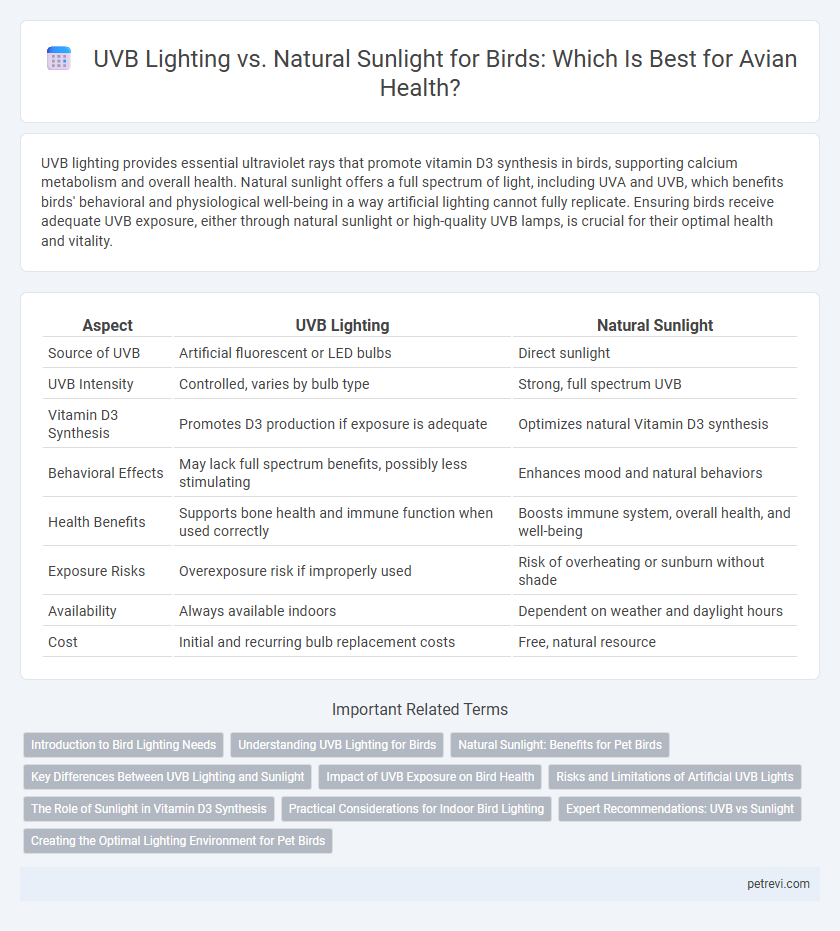UVB lighting provides essential ultraviolet rays that promote vitamin D3 synthesis in birds, supporting calcium metabolism and overall health. Natural sunlight offers a full spectrum of light, including UVA and UVB, which benefits birds' behavioral and physiological well-being in a way artificial lighting cannot fully replicate. Ensuring birds receive adequate UVB exposure, either through natural sunlight or high-quality UVB lamps, is crucial for their optimal health and vitality.
Table of Comparison
| Aspect | UVB Lighting | Natural Sunlight |
|---|---|---|
| Source of UVB | Artificial fluorescent or LED bulbs | Direct sunlight |
| UVB Intensity | Controlled, varies by bulb type | Strong, full spectrum UVB |
| Vitamin D3 Synthesis | Promotes D3 production if exposure is adequate | Optimizes natural Vitamin D3 synthesis |
| Behavioral Effects | May lack full spectrum benefits, possibly less stimulating | Enhances mood and natural behaviors |
| Health Benefits | Supports bone health and immune function when used correctly | Boosts immune system, overall health, and well-being |
| Exposure Risks | Overexposure risk if improperly used | Risk of overheating or sunburn without shade |
| Availability | Always available indoors | Dependent on weather and daylight hours |
| Cost | Initial and recurring bulb replacement costs | Free, natural resource |
Introduction to Bird Lighting Needs
Birds require specific lighting conditions to regulate their circadian rhythms, vitamin D synthesis, and overall health, making proper bird lighting essential. UVB lighting replicates the ultraviolet spectrum necessary for calcium metabolism and bone strength, though it lacks the full spectrum benefits of natural sunlight. Natural sunlight provides a comprehensive range of wavelengths that support behavioral patterns, feather condition, and immune function, often surpassing artificial UVB light in mimicking natural environmental conditions.
Understanding UVB Lighting for Birds
UVB lighting is essential for birds as it helps synthesize vitamin D3, which is crucial for calcium absorption and bone health. Natural sunlight provides full-spectrum UVB rays, promoting optimal health and well-being in birds by supporting proper metabolism and immune function. While UVB bulbs can supplement indoor lighting, replicating the intensity and spectrum of natural sunlight remains challenging.
Natural Sunlight: Benefits for Pet Birds
Natural sunlight provides essential full-spectrum UVB rays critical for pet birds' calcium metabolism and vitamin D3 synthesis, promoting healthy bone development and preventing metabolic bone disease. Exposure to natural sunlight regulates birds' circadian rhythms, enhancing their overall mood, reproductive behavior, and immune system function. Unlike artificial UVB lighting, sunlight offers a broad spectrum of wavelengths supporting visual perception and feather coloration, vital for birds' well-being and natural behaviors.
Key Differences Between UVB Lighting and Sunlight
UVB lighting emits a specific wavelength range essential for birds' vitamin D3 synthesis, while natural sunlight provides a broader spectrum including UVA, UVB, and visible light, crucial for overall avian health and behavior. UVB bulbs offer controlled exposure reducing overexposure risks, whereas sunlight delivers variable intensity and duration affected by weather and geographic location. Both sources support calcium metabolism, but natural sunlight better promotes feather coloration and mood regulation through UVA rays.
Impact of UVB Exposure on Bird Health
UVB exposure plays a crucial role in bird health by facilitating vitamin D3 synthesis, which is essential for calcium metabolism and strong bone development. Natural sunlight provides a full spectrum of UVB rays that promote optimal immune function and feather quality compared to artificial UVB lighting, which may vary in intensity and wavelength accuracy. Inadequate UVB exposure can lead to metabolic bone disease, weakened immune responses, and poor plumage condition in birds.
Risks and Limitations of Artificial UVB Lights
Artificial UVB lights for birds can cause uneven exposure, leading to potential eye damage or burns if improperly positioned or used excessively. Unlike natural sunlight which offers a full spectrum of rays, UVB bulbs often lack UVA and infrared wavelengths essential for bird health. These lights also degrade over time, reducing their effectiveness and necessitating regular replacement to avoid nutritional deficiencies and compromised vitamin D3 synthesis in birds.
The Role of Sunlight in Vitamin D3 Synthesis
UVB lighting plays a crucial role in providing captive birds with the necessary wavelengths to synthesize Vitamin D3, essential for calcium metabolism and bone health. Natural sunlight remains the most effective source of UVB radiation, promoting optimal Vitamin D3 production and overall well-being in birds. Lack of adequate UVB exposure, whether from artificial lighting or sunlight, can lead to deficiencies, affecting their immune function and skeletal development.
Practical Considerations for Indoor Bird Lighting
UVB lighting is essential for indoor birds to synthesize vitamin D3, promoting healthy calcium metabolism and preventing metabolic bone disease. Natural sunlight remains the most effective UVB source but requires safe exposure strategies to avoid overheating or stress from direct rays. When installing artificial UVB lamps, ensure proper distance, duration, and replacement schedule to mimic sunlight benefits without harming bird welfare or encouraging excessive heat.
Expert Recommendations: UVB vs Sunlight
Expert recommendations emphasize that natural sunlight provides the most effective UVB spectrum for birds, supporting vitamin D3 synthesis essential for calcium metabolism and overall health. While artificial UVB lighting can supplement indoor environments, it often lacks the full spectrum and intensity found in natural sunlight, making direct exposure preferable when safely feasible. Proper UVB exposure, whether from sunlight or specialized lamps, is critical to prevent metabolic bone disease and maintain feather quality in various bird species.
Creating the Optimal Lighting Environment for Pet Birds
UVB lighting replicates the essential ultraviolet rays birds need to synthesize vitamin D3, crucial for calcium absorption and bone health. Natural sunlight offers a full spectrum of light, including UVA and UVB rays, supporting not only physical health but also mental well-being and natural behaviors in pet birds. Combining high-quality UVB bulbs with regular, supervised exposure to indirect natural sunlight creates the optimal lighting environment to ensure vibrant plumage, strong bones, and overall vitality in pet birds.
UVB lighting vs Natural sunlight for Bird lighting Infographic

 petrevi.com
petrevi.com